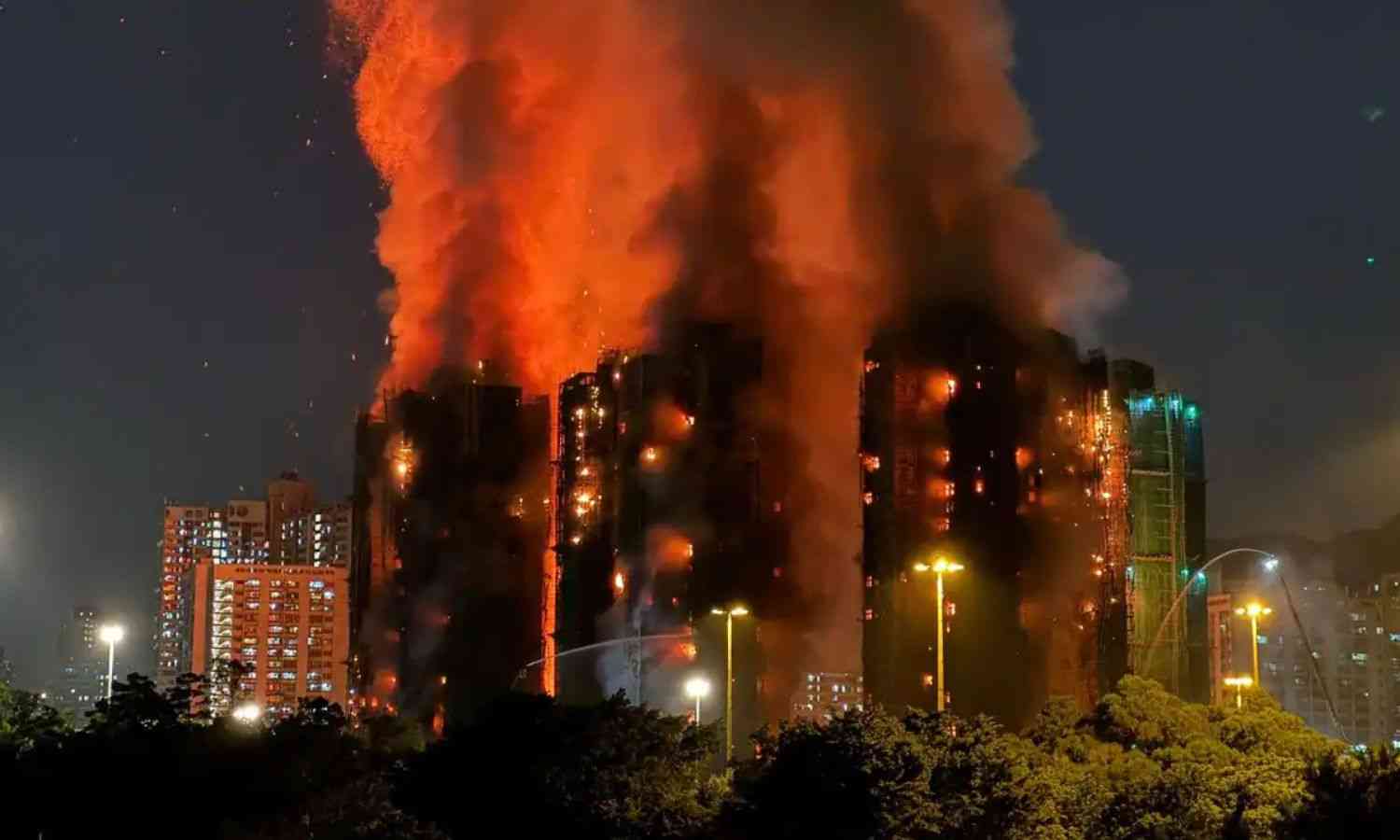A massive inferno ripped through Wang Fuk Court in Hong Kong’s Tai Po district on November 26, 2025, marking one of the city’s deadliest residential disasters in recent memory. What began as a localized fire on an exterior scaffold quickly transformed into a citywide tragedy — leaving 36 people dead, 279 missing, and hundreds displaced. As emergency teams continue to sift through debris and locate survivors, the incident has raised serious questions about fire-safety standards, renovation practices, and urban risk management in one of the world’s densest cities.
The blaze broke out a little before 3 p.m. local time, on a weekday afternoon when thousands of residents were indoors. Wang Fuk Court, a sprawling public-housing complex with nearly 2,000 flats and home to over 4,800 people, was undergoing exterior renovation. The buildings were wrapped in bamboo scaffolding — a common construction method in Hong Kong — covered with green plastic netting.
Investigators believe the fire started on one of these scaffolded sections. Eyewitnesses reported seeing sparks and then a sudden vertical streak of flames racing upward along the bamboo poles. Within minutes, the blaze spread from one block to another, helped by strong afternoon winds and the highly flammable construction materials.
Residents described hearing popping sounds, similar to exploding glass or plastic, followed by choking smoke seeping into hallways. Videos on social media captured terrifying visuals: flames shooting up the sides of the towers like a blowtorch, external scaffolding collapsing, and thick clouds of black smoke billowing across Tai Po.
What made the situation catastrophic was the speed. Firefighters later revealed that the blaze spread across seven of the estate’s eight residential blocks before they could establish containment. The bamboo scaffolding, which enveloped multiple towers simultaneously for renovation, created a continuous fuel channel that allowed the fire to jump between buildings.
In several blocks, residents were trapped in upper floors as blazing scaffold pieces fell past their windows. Some attempted to seal their doors and windows with wet towels; others retreated to rooftop areas or balconies to escape the smoke.
Emergency services received dozens of distress calls from people stuck on floors above the main fire line. Firefighters were dispatched immediately, but the scale — and height — of the blaze meant the entire firefighting fleet of the district was mobilized within minutes.
As of the latest update, 36 people are confirmed dead, including an on-duty firefighter who lost his life while rescuing trapped residents. Emergency teams have rescued several people in critical condition, but another 279 residents remain unaccounted for, making this the most severe high-rise fire incident in Hong Kong in decades.
Hospitals across the New Territories have admitted at least 29 injured residents, many with burns, smoke inhalation, and structural-collapse injuries. Medical authorities warn that the casualty count may rise as rescue operations continue.
Survivors recount harrowing escapes. One elderly woman described how she crawled down 20 floors in darkness as the stairwell filled with hot smoke. Another resident, a young mother, said she held her two-year-old close as firefighters smashed her window from the outside and pulled them to safety via hydraulic platform.
Families separated during evacuation have gathered at temporary relief centers, scanning printed lists of survivors and waiting desperately for updates. Some have spent the entire night outside the estate, hoping for any sign of missing relatives.
Local officials declared a No. 5 alarm — the highest classification of emergency response in Hong Kong — within the first hour. More than 250 firefighters and dozens of fire engines were deployed across the district.
But the scale of the blaze presented unique challenges:
-
Height & structure: Standard water jets could not reach the upper scaffolded floors effectively.
-
External spread: The fire was primarily on the outside — a rare and dangerous pattern for high-rise fires.
-
Wind conditions: Strong winds accelerated horizontal spread between towers.
-
Falling debris: Burning bamboo pieces and metal poles rained down, forcing firefighters to change strategies repeatedly.
Firefighters worked through the evening to contain the outer walls before entering smoke-filled interiors. Several rescues took place after sunset, with drones helping locate stranded residents through window signals and heat signatures.
Experts are now focusing on why the fire spread so aggressively across multiple towers. Early assessments indicate:
-
Bamboo Scaffolding
Lightweight and flexible, bamboo has been a signature of Hong Kong construction for decades — but it is also highly flammable when dry. -
Plastic Netting
The green mesh often used to contain dust can melt, ignite, and drip fire, accelerating spread. -
Continuous Wrapping
Renovation contractors had connected scaffolding around several blocks, unintentionally creating a single combustible structure linking multiple buildings. -
Renovation Materials
Paint cans, solvents, and construction tools stored on certain scaffolded floors may have further fueled the blaze.
Urban planners warn that such high-rise external scaffolding is inherently risky, but incidents at this scale are rare due to typically strict safety protocols.
As the flames engulfed building exteriors, police cordoned off the surrounding streets. Hundreds of residents rushed out with only essential belongings. Others — especially the elderly and disabled — were escorted by firefighters using breathing apparatus.
Community centers in Tai Po have been converted into temporary shelters. Volunteers distributed blankets, food, and essential supplies. Psychological support teams have been deployed to assist traumatized families and children.
Authorities have also set up a missing persons registration desk to track and verify the status of hundreds of residents.
While early evidence points to an accidental ignition during renovation, authorities have not ruled out other possibilities. Forensic teams are examining structural remains, scaffolding fragments, and CCTV footage to pinpoint the exact cause.
Questions investigators are exploring include:
-
Was there negligence in storing construction materials?
-
Was electrical wiring on the scaffolding faulty or exposed?
-
Were fire barriers installed according to safety standards?
-
Did contractors follow regulations for renovation on such a large estate?
A full inquiry is expected to take weeks.
As rescue workers continue their search and as authorities investigate the decisions and conditions leading up to the tragedy, Hong Kong is left grappling with a painful question: How can such a catastrophe be prevented from ever happening again?
With inputs from agencies
Image Source: Multiple agencies
© Copyright 2025. All Rights Reserved. Powered by Vygr Media.
























